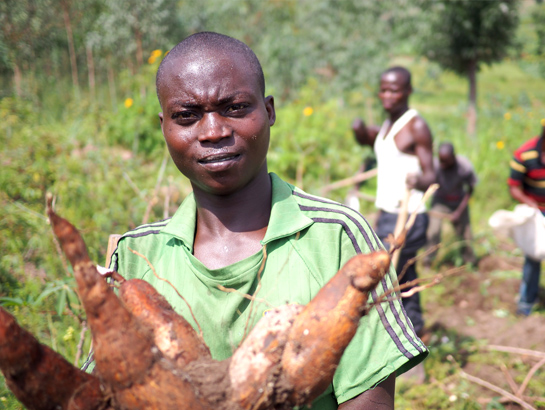This opinion piece originally appeared on devex.com on 20 August 2021.
There is no question that the COVID-19 pandemic has disrupted billions of lives around the world. We also know that the impacts extend well beyond the direct health toll of the virus. A recent report from the United Nations estimates that as many as 811 million people — nearly one-tenth of the global population — were undernourished in 2020, an increase of more than 100 million people from 2019. Pandemic-related disruptions to food systems, income streams, and dietary support programs are playing a major role.
Global hunger and malnutrition were daunting challenges before the pandemic. In 2019, an estimated two billion people were suffering from a form of malnutrition known as hidden hunger — caused by diets lacking in essential vitamins and minerals, or micronutrients, needed to maintain good health, mental and physical performance, and brain and body development in children.
Many people who suffer from hidden hunger cannot regularly afford to eat many nutrient-rich foods such as fruits, vegetables, dairy, and meats. They rely instead on relatively inexpensive, less perishable, but less nutritious staples to fill their stomachs. This is the common state of affairs for hundreds of millions of low-income smallholder farming families in rural Africa, Asia, and Latin America, who largely depend on rice, wheat, maize, and other staple crops they grow themselves.
Hidden hunger causes high rates of physical and cognitive impairments, anemia, stunting, and blindness, as well as weakened immune systems, which leave those afflicted prone to diarrhea and other infections — as well as to viruses such as COVID-19. The consequences are devastating, preventing people and their countries from reaching their full potential.
An opportunity for action
This year, participants at two international summits — the UN Food Systems Summit, or UNFSS, in September and the Tokyo Nutrition for Growth Summit in December — will seek agreements on strategies for transforming food and health systems to significantly and sustainably reduce rates of hunger and malnutrition for everyone.
On July 28, at the close of a preparatory “pre-summit” event for the UNFSS in Rome, UN Deputy Secretary-General Amina Mohammed wrapped up the deliberations by observing a united belief among UN member states that “within food systems lies the potential to achieve all of the [development] goals for people, planet, and prosperity.” However, she said there is also recognition that “our challenges are urgent and must be addressed at scale.”
The United States is uniquely placed to set a high bar at this year’s summits to address hunger and malnutrition — just as it has done in the past to tackle other major global challenges, and always with a view on ensuring that any responses reach and benefit the world’s most vulnerable populations.
For example, during the 2000s, the United States Agency for International Development implemented the landmark President’s Emergency Plan for AIDS Relief and the President’s Malaria Initiative, which helped shift trajectories of these health threats, and made a positive difference in the lives of millions of people in low- and middle-income countries.
Addressing hidden hunger should be a high priority for the U.S. This requires a multidimensional response including measures such as improving dietary diversity, large-scale food fortification, and supplementation. It should also include a proven, practical, and cost-effective approach that is tailored to the economic circumstances and nutritional needs of rural farming families: Biofortified staple crops.
These varieties of common food crops are naturally bred to contain higher levels of key micronutrients, particularly iron, zinc, and vitamin A. Research has shown that they improve nutrition and health status when eaten regularly, and cost farming families no more to grow than non-biofortified counterparts. Their nutritional value also stays in the seed, harvest after harvest, requiring little ongoing investment on the part of the families.
These nutritious crops are already benefiting about 50 million people in smallholder households in low- and middle-income countries. India, Bangladesh, Nigeria, and Rwanda are among the countries that have already shown that scaling up use of biofortified crops and foods can have a positive impact on the lives and livelihoods of vulnerable communities.
The US can lead the way
Biofortification is in fact one of the high-impact nutrition interventions recommended for priority expansion by the U.S. government in a new policy proposal called Nourish the Future. The proposal is endorsed by over 100 experts in global nutrition, agriculture and global health, who are calling on the U.S. to lead strengthening both health and food systems to combat malnutrition. They urge scaling up proven interventions like biofortification so that farmer-driven food value chains can affordably deliver safer and more nutritious products.
In addition to advancing key nutrition-related strategies, the U.S. should also support measures that help seed, crop, and food value chains function more efficiently in low- and middle-income countries. Key elements of this would include road, communications, and other infrastructure improvements; improving food safety regulations; and strengthening product tracing practices to help ensure that nutritious food options are identifiable in markets.
The interventions like those recommended in Nourish the Future are specific, scalable, and sustainable. When implemented in nine high-need countries, the five-year plan outlined in Nourish the Future would mean reaching 125 million more people with biofortified crops, and increasing access to sustainably healthy diets for a combined 63 million mothers and children. Further, if the proposal is fully implemented, Nourish the Future could cut severe malnutrition in half, and reduce child deaths by up to 11% in these countries.
In this summit year, the Biden administration has an opportunity to lead the way by adopting these proposals. The world is at a critical crossroads as we aim to build back better and stronger food systems. This is the time to assert a bold U.S. vision and leadership to decisively address hunger and all forms of malnutrition — including hidden hunger.
